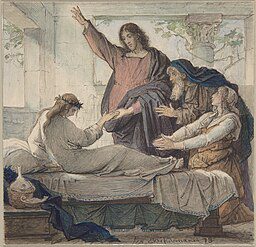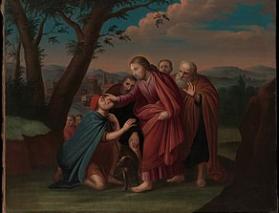
“Jesus wept”—the shortest verse in the New Testament—charged with emotion we should recognize. When Jesus wept with Mary, He knew He was going to raise her brother, Lazarus, from the dead. But He was weeping because Mary was weeping. He hurt because she hurt. Sometimes we rush to say what we ought or want to say a little too quickly. And we don’t sit with people and grieve the way Jesus grieved with Mary. In our awe over miracles, we may overlook the compassion behind miracles: the Savior’s feeling for individuals’ distress
Mary and Martha
I love the relationship of Mary, Martha, Lazarus, and Jesus—this lifetime friendship humanizes Christ for me. Lazarus would die again. Mary and Martha would die. So would the chief priests and the Pharisees. Jesus knew (as no one else could possibly know) how He would conquer death for all. But behind miracles on earth, He felt their grief; he shared it.
Martha and Mary thought Jesus were referring only to eternal principles when He spoke of faith and life. Jewish people of that time thought the spirit of someone who died would remain with the body three days, and life was still possible; but by the fourth day that hope was lost. Martha summed up their despair: “By this time he stinketh.” Jesus delayed arriving because He knew the people needed to see the fourth day come; He was not fulfilling the superstition.
But He still sorrowed for His friends’ sorrow. Linda S. Reeves, a former general Relief Society counselor, assured,
Heavenly Father and our Savior, Jesus Christ, know us and love us. They know when we are in pain or suffering in any way. . . They feel the depth of our suffering, and we can feel of Their love and compassion in our suffering. 1
Jairus
In his book Compassion: The Great Healer’s Art, Ulisses Soares referred to “how the Savior, moved by His deep and abiding compassion, interacted with the people of His day” and how He “extended his merciful hand to those who needed relief from their burdens, both physically and spiritually.”
Elder Soares recalled Christ’s compassionate response to Jairus, who pleaded with Him to come and lay His hands on his 12-year-old daughter, who was dying. As they struggled through crowds, a messenger intercepted them to say that she had died. Jairus held to his faith, and Jesus “comforted the heart of that father saying: ‘Fear not: believe only, and she shall be made whole’ (emphasis added).” 2
Jairus’s house was filled with people, loudly mourning. Understanding the parents’ emotions and their need for privacy, Jesus allowed only the girl’s parents (both parents) and Peter, James, and John in the healing room. He told the young girl to “arise,” and she did. As always, Jesus was conscious of feelings and emotions behind miracles. He used the common practice of telling her parents to give her something to eat: something to focus on and to keep them away from the noisy crowd—who were not to be told what had happened.
The crowd around Lazarus needed to watch the miracle; the crowd at Jairus’s home would have disturbed the solemnity of the blessing.
The Widow of Nain
Widows in Christ’s time often suffered both agonizing loss and desperate conditions. Women could not own property, so an adult son must provide support. A widow in the village of Nain had just lost her son, her only child. Grief must have been excruciating, and the side issue of future survival could add helplessness.
The compassionate Savior knew who she was, how she was suffering, and exactly where and what time the burial procession would pass. And He was there. “Weep not,” he told told her gently and reassuringly. Touching the bier, He firmly instructed, “Young man, I say unto thee, Arise.” The young man obeyed, sat up, and spoke. The miracle was finished; the Savior could have quickly been on His way.
But the compassion behind miracles needed more. Jesus “delivered him to his mother.” Elder Ronald W. Rasband concluded, as I have, that responding to his mother’s feelings with this personal loving gesture “extended a bond between them.” 3
A Tormented Family
“Master, I have brought unto thee my son, which hath a dumb spirit . . . And wheresoever he taketh him, he tareth him: and he foameth, and gnasheth with his teeth, and pineth away.” A miracle was needed. From it, observers then and readers now can learn the depth of compassion behind miracles by the Savior.
The boy had been afflicted since early childhood; often the malevolent spirit had cast him into fire or waters. His father pleaded, “If thou cast do any thing, have compassion on us and help us.” Elder Jeffrey R. Holland, identified “last-resort desperation” in the father’s voice, emphasizing the pronoun us. Elder Holland explained, “This man is saying . . . ‘Our whole family is pleading. Our struggle never ceases. We are exhausted. Our son . . . is continually in danger, and we are continually afraid’”(emphasis added). 4
There was no lecture, no admonition, no questions—just a gentle reassurance: “if thou canst believe, all things are possible to him that believeth.” Jesus used “believe”—He wasn’t requiring a firm testimony. With no hesitation, the child’s father “cried out, and said with tears, Lord I believe; help thou mine unbelief.” He knew his faith was not perfect. But he loved his son, and he responded to the sincere, nonjudgmental Savior who stood before him.
Jesus cast out the spirit; it didn’t go easily, and the boy seemed to be dead. Jesus tenderly “took him by the hand, and lifted him up.” These personal gestures beyond miracles show the love behind miracles (see Mark 9:20-27).
Raising the dead or the almost dead was among the miracles of Jesus Christ. He understood grief, and He reached out personally to those with mental and emotional suffering—the compassion behind miracles.
(Image by Bendemann/Wikimedia Commons)













